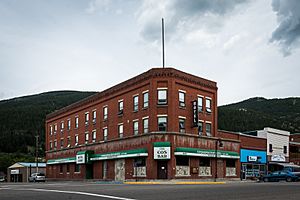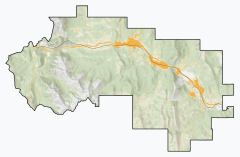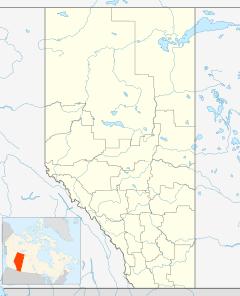Blairmore, Alberta facts for kids
Quick facts for kids
Blairmore
Tenth Siding
The Springs |
|
|---|---|
|
Former village
|
|

The Cosmopolitan Hotel and Bar in Blairmore
|
|
| Country | Canada |
| Province | Alberta |
| Census division | No. 15 |
| Specialized municipality | Municipality of Crowsnest Pass |
| Village | September 3, 1901 |
| Town | September 29, 1911 |
| Amalgamated | January 1, 1979 |
| Government | |
| • Type | Unincorporated |
| Area | |
| • Land | 2.04 km2 (0.79 sq mi) |
| Population
(2021)
|
|
| • Total | 1,522 |
| • Density | 741.6/km2 (1,921/sq mi) |
| Time zone | UTC−7 (MST) |
| • Summer (DST) | UTC−6 (MDT) |
Blairmore is a community in the Rocky Mountains within the Municipality of Crowsnest Pass in southwest Alberta, Canada. It was formerly incorporated as a town prior to 1979 when it amalgamated with four other municipalities to form Crowsnest Pass. Blairmore is the principal commercial centre of Crowsnest Pass.
History
Originally a Canadian Pacific Railway stop called Tenth Siding or The Springs (for the cold sulphur spring to the east), the settlement was renamed Blairmore in November 1898 and it got a post office the following year. A ten-year dispute over land ownership between the CPR station agent and the section foreman stunted early development. Blairmore’s principal industry was lumber and, after 1907, coal. Other industries followed and on September 29, 1911 Blairmore was incorporated as a town. With the declining fortunes of the nearby community of Frank, Blairmore soon became the region’s economic centre. The Greenhill mine, located just north of Blairmore, became the mainstay of the community until its closure in 1957.
Like many Canadian industrial towns in the 1930s, Blairmore had some sympathies with Communism. Canada's first Communist town council and school board were elected in Blairmore in 1933, which reformed the tax system, and refused to observe Remembrance Day as an Imperialist holiday and honoured the Russian Revolution instead. A street was named after the leader of the Communist Party of Canada, Tim Buck, a decision that was reversed by the next town council.
Blairmore amalgamated with four other municipalities to form the Municipality of Crowsnest Pass in 1979.
Geography
Blairmore is located in southwest Alberta in the Canadian Rockies. It is approximately 135 km (84 mi) west of Lethbridge on Highway 3 (Crowsnest Highway) and approximately 20 km (12 mi) east of the British Columbia border. Fellow Crowsnest Pass communities Frank and Coleman are 3 km (1.9 mi)* to the east and 6 km (3.7 mi)* to the west respectively.
- Geology
Volcanic rocks in the Blairmore area are related to the Crowsnest Formation. As a geological unit, the volcanics received some attention in the late 1980s when geologists stated they had found trace amounts of gold in certain units of the volcanics. Blairmorite, a rare volcanic rock of the Crowsnest Formation, is named after Blairmore.
Demographics
| Population history of Blairmore | ||||||||||||||||||||||||||||||||||||||||||||||||||||||||||||||||||||||||||||||||||
|---|---|---|---|---|---|---|---|---|---|---|---|---|---|---|---|---|---|---|---|---|---|---|---|---|---|---|---|---|---|---|---|---|---|---|---|---|---|---|---|---|---|---|---|---|---|---|---|---|---|---|---|---|---|---|---|---|---|---|---|---|---|---|---|---|---|---|---|---|---|---|---|---|---|---|---|---|---|---|---|---|---|---|
|
|
|||||||||||||||||||||||||||||||||||||||||||||||||||||||||||||||||||||||||||||||||
| Source: Statistics Canada | ||||||||||||||||||||||||||||||||||||||||||||||||||||||||||||||||||||||||||||||||||
In the 2021 Census of Population, the urban population centre of Blairmore, as delineated by Statistics Canada, recorded a population of 1,522 living in 731 of its 896 total private dwellings, a change of -1.5% from its 2016 population of 1,545. With a land area of 2.04 km2 (0.79 sq mi), it had a population density of 746.1/km2 (1,932/sq mi) in 2021.
As a population centre in the 2016 Census of Population conducted by Statistics Canada, Blairmore recorded a population of 1,545 living in 731 of its 886 total private dwellings, a 1.6% change from its 2011 population of 1,521. With a land area of 2.04 km2 (0.79 sq mi), it had a population density of 757.4/km2 (1,962/sq mi) in 2016.



